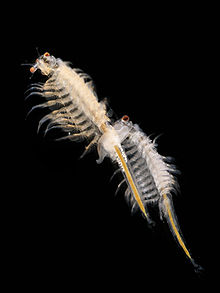Artemia salina
| Artemia salina | |
|---|---|
 |
|
| Scientific classification | |
| Kingdom: | Animalia |
| Phylum: | Arthropoda |
| Subphylum: | Crustacea |
| Class: | Branchiopoda |
| Order: | Anostraca |
| Family: | Artemiidae |
| Genus: | Artemia |
| Species: | A. salina |
| Binomial name | |
|
Artemia salina (Linnaeus, 1758) |
|
Artemia salina is a species of brine shrimp – aquatic crustaceans that are more closely related to Triops and cladocerans than to true shrimp. It is a very old species that does not appear to have changed in 100 million years.
Artemia salina have three eyes and 11 pairs of legs and can grow to about 15 millimetres (0.6 in) in size. Their blood contains the pigment haemoglobin, which is also found in vertebrates. Males differ from females by having the second antennae markedly enlarged, and modified into clasping organs used in mating.
Males have two reproductive organs. Prior to copulation the male clasps the female with his clasping organ, assuming a dorsal position. The claspers hold the female just anterior to the ovisac. Male and female may swim clasped together for a number of days. In this state, the movements of the swimming appendages of the pair beat in a co-ordinated fashion. The females can produce eggs either as a result of mating or via parthenogenesis. There are two types of eggs: thin-shelled eggs that hatch immediately and thick-shelled eggs, which can remain in a dormant state. These cysts can last for a number of years, and will hatch when they are placed in saltwater. Thick-shelled eggs are produced when the body of water is drying out, food is scarce, and the salt concentration is rising. If the female dies, the eggs develop further. Eggs hatch into nauplii that are about 0.5 mm in length. They have one single simple eye that only senses the presence and direction of light. Nauplii swim towards the light but adult individuals swim away from it. Later, the two more capable eyes develop but the initial eye also stays, resulting in three-eyed creatures.
In nature, they live in salt lakes. They are almost never found in an open sea, most likely because of the lack of food and relative defenselessness. However, Artemia have been observed in Elkhorn Slough, California, which is connected to the sea. Unlike most aquatic species, Artemia swims upside down.
...
Wikipedia
